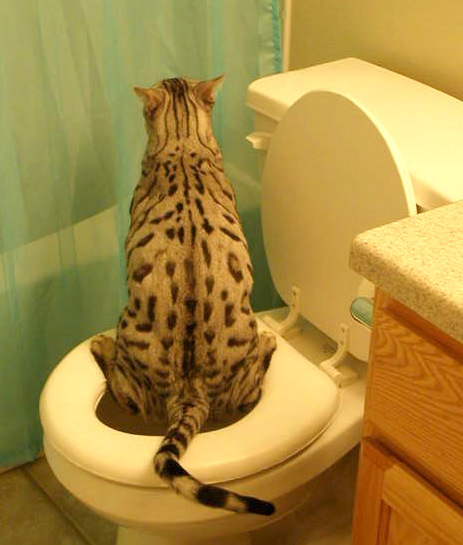Hazards of Flushing Cat Poop Down Your Toilet - Avoid Potential Issues
Hazards of Flushing Cat Poop Down Your Toilet - Avoid Potential Issues
Blog Article
We've stumbled on the article pertaining to Don’t flush cat feces down the toilet listed below on the web and accepted it made good sense to talk about it with you here.

Intro
As pet cat proprietors, it's essential to bear in mind how we get rid of our feline good friends' waste. While it might appear hassle-free to purge feline poop down the bathroom, this method can have harmful consequences for both the environment and human health.
Environmental Impact
Purging pet cat poop presents unsafe microorganisms and parasites into the water supply, presenting a substantial threat to water ecosystems. These impurities can negatively affect aquatic life and concession water quality.
Health Risks
Along with ecological issues, purging pet cat waste can also present wellness threats to human beings. Feline feces might include Toxoplasma gondii, a parasite that can cause toxoplasmosis-- a possibly extreme health problem, specifically for expecting ladies and people with damaged body immune systems.
Alternatives to Flushing
Luckily, there are more secure and extra accountable means to throw away feline poop. Take into consideration the complying with alternatives:
1. Scoop and Dispose in Trash
One of the most typical approach of taking care of feline poop is to scoop it right into a naturally degradable bag and toss it in the trash. Make sure to use a dedicated trash scoop and throw away the waste quickly.
2. Usage Biodegradable Litter
Go with naturally degradable pet cat clutter made from products such as corn or wheat. These litters are environmentally friendly and can be securely gotten rid of in the garbage.
3. Bury in the Yard
If you have a yard, think about hiding feline waste in an assigned location away from vegetable gardens and water sources. Be sure to dig deep enough to prevent contamination of groundwater.
4. Mount a Pet Waste Disposal System
Buy a family pet waste disposal system particularly created for feline waste. These systems use enzymes to break down the waste, lowering smell and ecological impact.
Verdict
Accountable pet ownership extends beyond supplying food and shelter-- it also involves correct waste monitoring. By refraining from purging pet cat poop down the commode and choosing alternate disposal approaches, we can decrease our environmental footprint and safeguard human health and wellness.
Why Can’t I Flush Cat Poop?
It Spreads a Parasite
Cats are frequently infected with a parasite called toxoplasma gondii. The parasite causes an infection called toxoplasmosis. It is usually harmless to cats. The parasite only uses cat poop as a host for its eggs. Otherwise, the cat’s immune system usually keeps the infection at low enough levels to maintain its own health. But it does not stop the develop of eggs. These eggs are tiny and surprisingly tough. They may survive for a year before they begin to grow. But that’s the problem.
Our wastewater system is not designed to deal with toxoplasmosis eggs. Instead, most eggs will flush from your toilet into sewers and wastewater management plants. After the sewage is treated for many other harmful things in it, it is typically released into local rivers, lakes, or oceans. Here, the toxoplasmosis eggs can find new hosts, including starfish, crabs, otters, and many other wildlife. For many, this is a significant risk to their health. Toxoplasmosis can also end up infecting water sources that are important for agriculture, which means our deer, pigs, and sheep can get infected too.
Is There Risk to Humans?
There can be a risk to human life from flushing cat poop down the toilet. If you do so, the parasites from your cat’s poop can end up in shellfish, game animals, or livestock. If this meat is then served raw or undercooked, the people who eat it can get sick.
In fact, according to the CDC, 40 million people in the United States are infected with toxoplasma gondii. They get it from exposure to infected seafood, or from some kind of cat poop contamination, like drinking from a stream that is contaminated or touching anything that has come into contact with cat poop. That includes just cleaning a cat litter box.
Most people who get infected with these parasites will not develop any symptoms. However, for pregnant women or for those with compromised immune systems, the parasite can cause severe health problems.
How to Handle Cat Poop
The best way to handle cat poop is actually to clean the box more often. The eggs that the parasite sheds will not become active until one to five days after the cat poops. That means that if you clean daily, you’re much less likely to come into direct contact with infectious eggs.
That said, always dispose of cat poop in the garbage and not down the toilet. Wash your hands before and after you clean the litter box, and bring the bag of poop right outside to your garbage bins.
https://trenchlesssolutionsusa.com/why-cant-i-flush-cat-poop/

As a keen reader on Don’t flush cat feces down the toilet, I was thinking sharing that piece of content was a good thing. For those who enjoyed our article kindly make sure you remember to pass it around. I appreciate reading our article about How to Dispose of Cat Poop and Litter Without Plastic Bags.
Visit Site Report this page